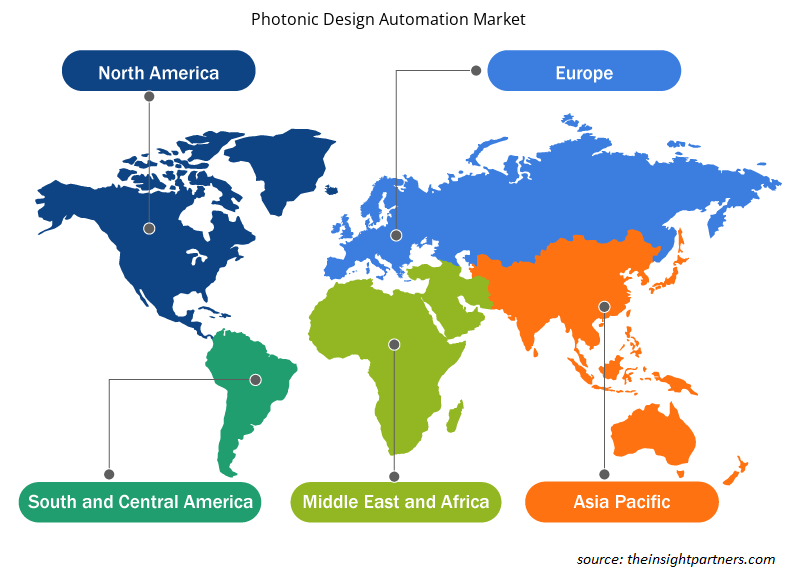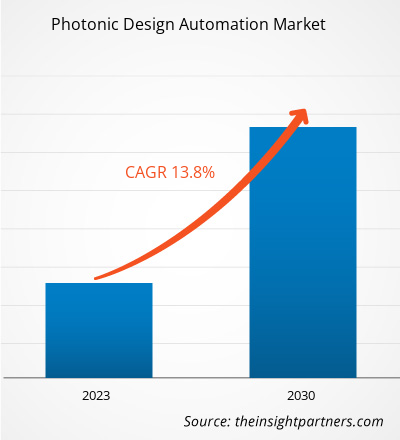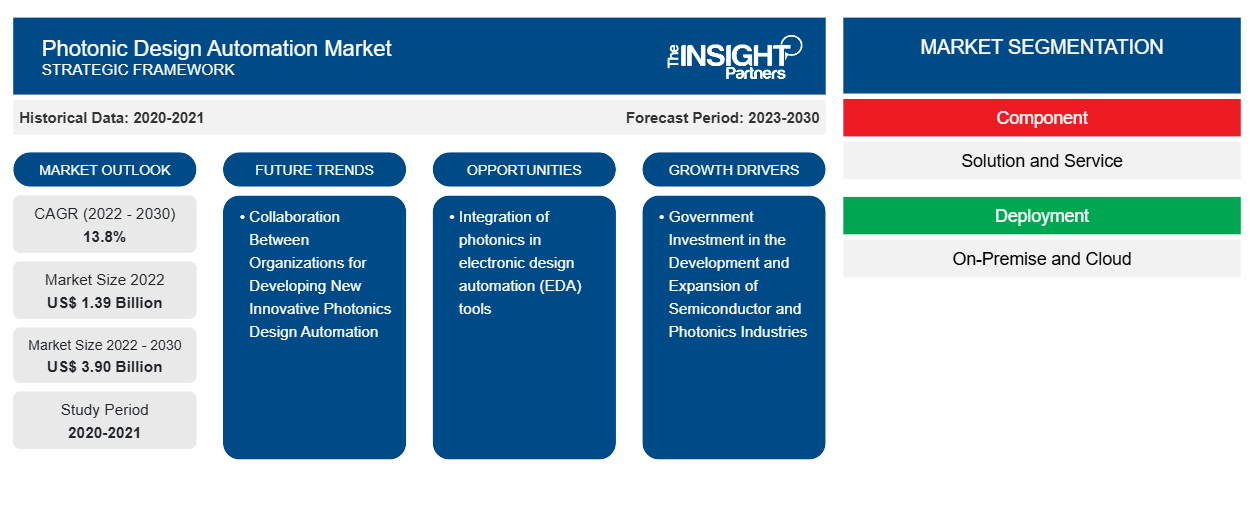光子设计自动化市场规模预计将从 2022 年的 13.9 亿美元增至 2030 年的 39 亿美元。预计 2022-2030 年期间市场复合年增长率将达到 13.8%。光子学与电子设计自动化 (EDA) 工具的集成可能仍是市场的主要趋势。
光子设计自动化市场分析
各组织为开发新型创新光子设计自动化而展开的合作以及对效率和准确性的日益增长的需求正在推动市场的发展。由于对自动化的需求不断增长,预计市场在预测期内将大幅扩张。此外,政府对半导体和光子学行业发展和扩张的投资以及对高性能和环境可持续解决方案的重视正在为市场创造丰厚的机会。
光子设计自动化市场概览
光子设计自动化需要软件工具和自动化技术,通过成功地将复杂的设计转换成功能芯片或设备,促进光子设备和系统的设计和开发。光子设计自动化,就像电子行业的电气设计自动化 (EDA) 一样,旨在加快和简化光子元件和系统的设计过程。它为设计人员提供了软件工具和自动化方法来创建原理图、布局和其他设计组件。光子设计自动化旨在提高光子设备和系统的设计和开发的效率、准确性和生产力。自动化某些活动并提供全面的模拟和分析功能有助于设计人员探索多种设计方案、最大限度地提高性能并最大限度地缩短上市时间。随着包括制造业在内的各种行业对自动化的需求不断增长,市场正在扩大。由于使用光子设计自动化的好处,例如提高生产力、简化设计流程和加快上市时间,自动化的需求很高。
定制此报告以满足您的需求
您可以免费定制任何报告,包括本报告的部分内容、国家级分析、Excel 数据包,以及为初创企业和大学提供优惠和折扣
-
获取此报告的关键市场趋势。这个免费样品将包括数据分析,从市场趋势到估计和预测。
光子设计自动化市场驱动因素和机遇
各组织合作开发新型创新光子设计自动化以利于市场
政府、工业界和学术界通过美国制造光子学研究所 (AIM Photonics) 等组织合作开发光子设计自动化。AIM Photonics 旨在通过促进电子光子设计自动化 (EPDA) 方面的合作和创新来推动光子行业的发展。例如,2023 年 5 月,AIM Photonics 推出了其最新产品:光电测试服务。这套新服务提供了全面的尖端工具和功能,用于测试光子集成电路 (PIC) 和传统电子集成电路 (IC)。AIM Photonics 的光电测试服务满足了集成电路领域对先进测试解决方案日益增长的需求。这些服务可以对光子和电子 IC 的性能、可靠性和功能进行全面评估和验证。
光子设计自动化市场的增长可以归因于电子设计自动化 (EDA) 行业的发展。EDA 工具最初专注于电子集成电路 (IC) 的设计和验证,但已扩展到包括光子设计功能。
政府对半导体和光子学产业发展和扩张的投资
光子设计自动化市场是一个充满活力的行业,支持光子技术的发展。加拿大政府支持发展全球光子设计自动化行业和提供该领域领先产品等举措。例如,2022 年 2 月,加拿大政府宣布向半导体和光子行业投资 2.4 亿美元。这一战略举措旨在促进这些行业的增长和竞争力,使加拿大成为增强制造业和技术创新的全球领导者。这项投资将支持尖端技术的发展、研发计划以及全国半导体和光子行业制造能力的扩展。它将促进产业、学术界和政府之间的合作,推动创新并创造新的就业机会。
光子报告分割分析
有助于得出光子分析的关键部分是组件、部署、组织规模和应用。
- 根据组件,光子设计自动化市场分为解决方案和服务。解决方案部分在 2022 年占据了更大的市场份额。
- 根据部署方式,市场分为本地部署和云部署。2022 年,本地部署部分占据了更大的市场份额。
- 就组织规模而言,市场分为中小型企业和大型企业。大型企业在 2022 年占据了更大的市场份额。
- 根据应用,光子设计自动化市场分为学术研究和工业研究与制造。工业研究与制造部门在 2022 年占据了更大的市场份额。
光子设计自动化市场份额按地区分析
光子设计自动化市场报告的地理范围主要分为五个区域:北美、亚太、欧洲、中东和非洲、南美和中美。
由于中国、韩国、日本和印度的光子学产业的存在,预计亚太地区的市场将在预测期内扩大。韩国在光子学行业占有重要地位,并以其在信息和通信技术方面的技术进步而闻名。这促进了该国光子学设计自动化市场的增长。技术进步、合作和研发投资推动了韩国市场的发展。制造业的自动化实施也在推动市场发展方面发挥着作用。光子设计自动化对于韩国的各种应用都至关重要,包括电信、数据中心、医疗保健和传感。它能够有效地操纵引导的电磁波,并有助于开发先进的光子器件。
光子设计自动化市场区域洞察
Insight Partners 的分析师已详细解释了预测期内影响光子设计自动化市场的区域趋势和因素。本节还讨论了北美、欧洲、亚太地区、中东和非洲以及南美和中美洲的光子设计自动化市场细分和地理位置。

- 获取光子设计自动化市场的区域特定数据
光子设计自动化市场报告范围
| 报告属性 | 细节 |
|---|---|
| 2022 年市场规模 | 13.9亿美元 |
| 2030 年市场规模 | 39亿美元 |
| 全球复合年增长率(2022 - 2030 年) | 13.8% |
| 史料 | 2020-2021 |
| 预测期 | 2023-2030 |
| 涵盖的领域 |
按组件
|
| 覆盖地区和国家 |
北美
|
| 市场领导者和主要公司简介 |
|
市场参与者密度:了解其对商业动态的影响
光子设计自动化市场正在快速增长,这得益于终端用户需求的不断增长,而这些需求又源于消费者偏好的不断变化、技术进步以及对产品优势的认识不断提高等因素。随着需求的增加,企业正在扩大其产品范围,进行创新以满足消费者的需求,并利用新兴趋势,从而进一步推动市场增长。
市场参与者密度是指在特定市场或行业内运营的企业或公司的分布情况。它表明在给定市场空间中,相对于其规模或总市场价值,有多少竞争对手(市场参与者)存在。
在光子设计自动化市场运营的主要公司有:
- Ansys公司
- LioniX国际有限公司
- VPlphotonics有限公司
- Optiwave 系统公司
- 卢塞达光子学
- Cadence设计系统公司
免责声明:上面列出的公司没有按照任何特定顺序排列。

- 获取光子设计自动化市场顶级关键参与者概览
光子设计自动化市场新闻和最新发展
光子设计自动化市场通过收集一手和二手研究后的定性和定量数据进行评估,其中包括重要的公司出版物、协会数据和数据库。以下列出了光子设计自动化市场的一些发展:
- Luceda Photonics 宣布与 Aluvia Photonics 合作,后者是全球首家集成光子学应用的 Al2O3 代工厂。此次合作为设计人员提供了 Luceda Photonics 设计平台内的高级工艺设计套件 (PDK),使其能够访问 Aluvia Photonics 即将推出的多项目晶圆 (MPW) 运行。(来源:Luceda Photonics,公司网站,2023 年 8 月)
- AIM Photonics 宣布推出其新的光电测试服务,该服务具有一整套先进的工具,可用于测试光子集成电路 (PIC) 以及传统电子 IC。(来源:AIM Photonics Inc,公司网站,2023 年 5 月)。
光子设计自动化市场报告覆盖范围和交付成果
“光子设计自动化市场规模和预测(2020-2030 年)”报告对以下领域进行了详细的市场分析:
- 光子设计自动化市场规模及全球、区域和国家层面所有关键细分市场的预测
- 光子设计自动化市场趋势以及市场动态,如驱动因素、限制因素和关键机遇
- 详细的 PEST/波特五力分析和 SWOT 分析
- 光子设计自动化市场分析涵盖主要市场趋势、全球和区域框架、主要参与者、法规和最新市场发展
- 行业格局和竞争分析,涵盖市场集中度、热图分析、知名参与者以及光子设计自动化市场的最新发展
- 详细的公司简介
- 历史分析(2 年)、基准年、预测(7 年)及复合年增长率
- PEST和SWOT分析
- 市场规模、价值/数量 - 全球、区域、国家
- 行业和竞争格局
- Excel 数据集
近期报告
客户评价
购买理由
- 明智的决策
- 了解市场动态
- 竞争分析
- 客户洞察
- 市场预测
- 风险规避
- 战略规划
- 投资论证
- 识别新兴市场
- 优化营销策略
- 提升运营效率
- 顺应监管趋势























 获取免费样品 - 光子设计自动化市场
获取免费样品 - 光子设计自动化市场